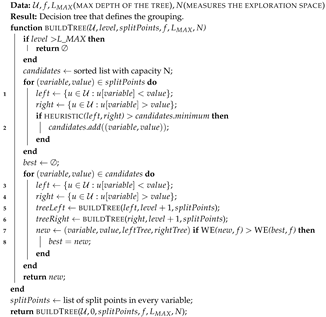Interpretable Market Segmentation on High Dimension Data †
Abstract
:1. Introduction
2. Proposal
| Algorithm 1: Grouping algorithm. |
 |
3. Results
Acknowledgements
Conflicts of Interest
References
- Hofmann, T.; Puzicha, J.; Jordan, M.I. Learning from dyadic data. In Advances in Neural Information Processing Systems; MIT Press: Cambridge, MA, USA, 1999; pp. 466–472. [Google Scholar]
- Koren, Y.; Bell, R.; Volinsky, C. Matrix factorization techniques for recommender systems. Computer 2009, 42, 30–37. [Google Scholar] [CrossRef]
- Luaces, O.; Díez, J.; Alonso-Betanzos, A.; Troncoso, A.; Bahamonde, A. A factorization approach to evaluate open-response assignments in MOOCs using preference learning on peer assessments. Knowl. Based Syst. 2015, 85, 322–328. [Google Scholar] [CrossRef]
- Luaces, O.; Díez, J.; Alonso-Betanzos, A.; Troncoso, A.; Bahamonde, A. Content-based methods in peer assessment of open-response questions to grade students as authors and as graders. Knowl. Based Syst. 2017, 117, 79–87. [Google Scholar] [CrossRef]
- Kotler, P.; Cox, K.K. Marketing Management and Strategy; Prentice Hall: Upper Saddle River, NJ, USA, 1980. [Google Scholar]
- Lipton, Z.C. The mythos of model interpretability. arXiv 2016, arXiv:1606.03490. [Google Scholar]
- Zaharia, M.; Xin, R.S.; Wendell, P.; Das, T.; Armbrust, M.; Dave, A.; Meng, X.; Rosen, J.; Venkataraman, S.; Franklin, M.J.; et al. Apache spark: A unified engine for big data processing. Commun. ACM 2016, 59, 56–65. [Google Scholar] [CrossRef]
- Díez, J.; Pérez, P.; Luaces, O.; Bahamonde, A. Readers Segmentation According to their Preferences to Click Promoted Links in Digital Publications; Technical Report; Universidad de Oviedo: Oviedo, Spain, 2018. [Google Scholar]
Publisher’s Note: MDPI stays neutral with regard to jurisdictional claims in published maps and institutional affiliations. |
© 2018 by the authors. Licensee MDPI, Basel, Switzerland. This article is an open access article distributed under the terms and conditions of the Creative Commons Attribution (CC BY) license (https://creativecommons.org/licenses/by/4.0/).
Share and Cite
Eiras-Franco, C.; Guijarro-Berdiñas, B.; Alonso-Betanzos, A.; Bahamonde, A. Interpretable Market Segmentation on High Dimension Data. Proceedings 2018, 2, 1171. https://doi.org/10.3390/proceedings2181171
Eiras-Franco C, Guijarro-Berdiñas B, Alonso-Betanzos A, Bahamonde A. Interpretable Market Segmentation on High Dimension Data. Proceedings. 2018; 2(18):1171. https://doi.org/10.3390/proceedings2181171
Chicago/Turabian StyleEiras-Franco, Carlos, Bertha Guijarro-Berdiñas, Amparo Alonso-Betanzos, and Antonio Bahamonde. 2018. "Interpretable Market Segmentation on High Dimension Data" Proceedings 2, no. 18: 1171. https://doi.org/10.3390/proceedings2181171
APA StyleEiras-Franco, C., Guijarro-Berdiñas, B., Alonso-Betanzos, A., & Bahamonde, A. (2018). Interpretable Market Segmentation on High Dimension Data. Proceedings, 2(18), 1171. https://doi.org/10.3390/proceedings2181171



